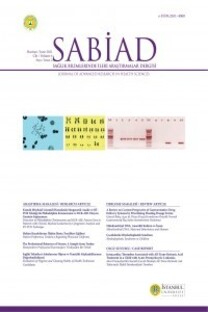INVESTIGATION OF THE POTENTIAL EFFECTS OF YAP-1 AND NESTIN ON RISK CLASSES AND PROGNOSIS IN NEUROBLASTOMA
Introduction: Neuroblastoma (NB) is the most common solid tumors in childhood. MYCN is the main prognostic factor for risk classification and staging in NB patients. YAP (Yes Associated Protein) plays a critical role in many types of cancer. In NB, YAP expression levels may be correlate with advanced tumor staging. Nestin is an important neuronal differentiation and cancer stem cell marker in NB. The aim of this study is to examine the potential roles of YAP-1 and Nestin expressions in terms of prognosis and risk classifications for neuroblastoma. Materials and Methods: Histological tumor sections of 55 cases were examined. YAP-1 and Nestin protein expression levels were evaluated by immunohistochemical staining on paraffin sections of different neuroblastoma risk groups. YAP-1 and Nestin expression levels were evaluated with clinical findings of NB patients. P value was <0.05 accepted as a statistically significant. Results: 55 patient tissues were included in this study, of which 24 were male and 21 were female. The ages of the patients are between 1 month to 11 years. YAP-1 protein was expressed in 36.4% in MYCN(+)and 14.6% in MYCN(-) patients. Nestin protein was expressed 36.4% in MYCN(+), and 20.6% in MYCN(-) patients. YAP-1 was expressed 18% in all tissues. Nestin expressions were determined 20.4% in all tissues. YAP-1 was expressed in 26.9% in highrisk and 11.5% in low-risk groups. Nestin was expressed 24.4% in high-risk and 33.3% in low-risk groups. Conclusion: YAP-1 and Nestin might be a clinically risk markers for neuroblastoma patients.
INVESTIGATION OF THE POTENTIAL EFFECTS OF YAP-1 AND NESTIN ON RISK CLASSES AND PROGNOSIS IN NEUROBLASTOMA
Introduction: Neuroblastoma (NB) is the most common solid tumors in childhood. MYCN is the main prognostic factor for risk classification and staging in NB patients. YAP (Yes Associated Protein) plays a critical role in many types of cancer. In NB, YAP expression levels may be correlate with advanced tumor staging. Nestin is an important neuronal differentiation and cancer stem cell marker in NB. The aim of this study is to examine the potential roles of YAP-1 and Nestin expressions in terms of prognosis and risk classifications for neuroblastoma. Materials and Methods: Histological tumor sections of 55 cases were examined. YAP-1 and Nestin protein expression levels were evaluated by immunohistochemical staining on paraffin sections of different neuroblastoma risk groups. YAP-1 and Nestin expression levels were evaluated with clinical findings of NB patients. P value was <0.05 accepted as a statistically significant. Results: 55 patient tissues were included in this study, of which 24 were male and 21 were female. The ages of the patients are between 1 month to 11 years. YAP-1 protein was expressed in 36.4% in MYCN(+)and 14.6% in MYCN(-) patients. Nestin protein was expressed 36.4% in MYCN(+), and 20.6% in MYCN(-) patients. YAP-1 was expressed 18% in all tissues. Nestin expressions were determined 20.4% in all tissues. YAP-1 was expressed in 26.9% in highrisk and 11.5% in low-risk groups. Nestin was expressed 24.4% in high-risk and 33.3% in low-risk groups. Conclusion: YAP-1 and Nestin might be a clinically risk markers for neuroblastoma patients.
___
- Grozescu T, Popa F. Prostate cancer between prognosis and adequate/proper therapy. J Med Life. 2017;10(1):5-12
